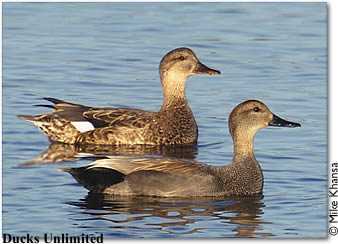 Gadwall GadwallAnas
strepera
Description
Gadwalls range in size from 18
to 22 inches long and 1 to 2½ pounds in weight,
with both sexes being about the same size.
Males and females look very
much alike most of the year, with generally drab
plumage lacking distinctive markings. A white
speculum is the most distinctive marking on a
gadwall, but it is only visible when the bird is
in flight.
During the breeding season the
male's plumage becomes grayish with distinct
vermiculation on the scapular and back feathers,
the head turns brown, and the upper and lower
tail covers turn black. The most distinguishing
features of a male during this period are its
long, acutely-pointed, silver-gray tertial
feathers.
Distribution and
Habitat
Gadwalls winter from southern
Mexico and Guatemala to coastal Alaska, the
Atlantic and Gulf coast regions of the United
States, and many areas in between. Their summer
breeding grounds range from the Atlantic coast of
Canada to the far northwestern coast of Alaska,
with the largest concentrations being found in
the prairie pot-hole region of southern Canada
and northern United States. Some populations can
also be found breeding in Iceland, the British
Isles, and northern Eurasia.
Gadwalls prefer marshes,
sloughs, ponds, and small lakes with grasslands
in both fresh and brackish water as breeding
habitats. They are more commonly found on small
prairie marshes than in temporary water areas,
deep marshes, or open water marshes, and they
generally avoid wetlands that are bordered by
woodlands or thick vegetation. In the winter they
prefer the brackish water marshes with abundant
leafy vegetation.
Reproduction
Gadwalls engage in elaborate
courtship displays prior to mating. They are
generally monogamous in their breeding behavior,
and pair bonds are frequently renewed each year.
The female usually chooses a
nest site near her natal nesting grounds. The
male stands guard while the female constructs the
nest, which typically consists of a despression
in the soil lined with leaves, grasses, twigs,
and down feathers. The clutch of 7 to 13 eggs is
laid at the rate of one egg per day, and is
incubated by the female for about 26 days.
Gadwall chicks are able to
procure their own food almost immediately after
hatching and are only cared for by the mother for
about 10 weeks.
If the nest is predated, the
female will usually make another nest and lay a
second clutch.
Diet
Gadwalls feed on aquatic
vegetation, aquatic invertebrates, and seeds.
Their main diet of plant material includes leaves
and stems of aquatic plants, all of which are
obtained by surface feeding. They can also be
found in fields feeding on grain or in woodlands
feeding on acorns. They supplement their plant
diet with insects, crustaceans, amphibians,
mollusks, and fish.
Habits and Behaviors
Gadwalls typically migrate in
flocks of less than 100 individuals, but as many
as 10,000 may migrate in separate groups to the
same destination, arriving within hours of each
other. Although they are diurnal in their daily
behavior, migration flights usually take place at
night.
Scientific
Classification
phylum Chordata
subphylum Vertebrata
class
Aves
order
Anseriformes
family Anatidae
subfamily Anatinae
genus & species Anas strepera

Animal Diversity Web http://animaldiversity.org/accounts/Anas_strepera/
Questions or comments about
this page?
|



